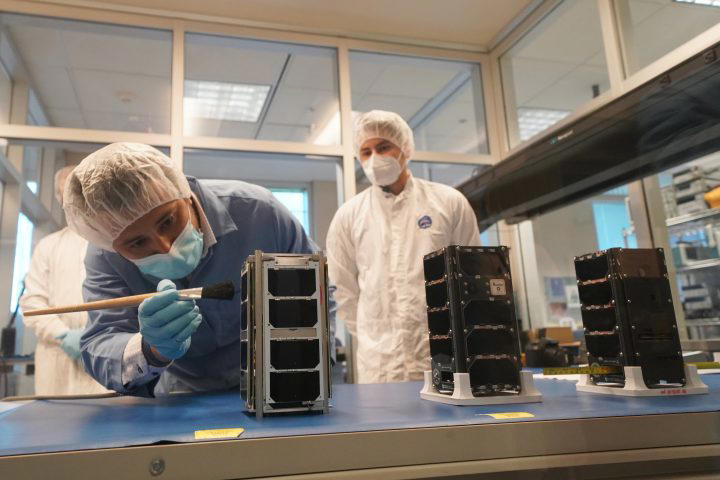Story by Saba Aziz • June 3,2023

The Canadian CubeSat Project provides teams of students in post-secondary institutions with the unique opportunity to design and build their own miniature satellite called a CubeSat.© Credit: Canadian Space Agency
Canadian university students are setting their sights on space exploration, with the launch of miniature cube-shaped satellites that they designed and built over the past five years.
Teams from Concordia University, the University of Manitoba, the University of Saskatchewan, York University and Western University will see their work make its way to the International Space Station on Saturday.
A month later those mini-satellites will be deployed into their final orbit, allowing the students to collect data and imaging from space.
The launch from NASA’s Kennedy Space Center in Florida is part of the Canadian CubeSat Project that started in 2018, involving more than 2,000 students across Canada.
Its aim is to boost interest in science, technology, engineering and mathematics while involving students in real space missions.
“(It’s) a very exciting moment for students in Canada who wish and dream of working in the space industry,” said Tony Pellerin, a Canadian Space Agency (CSA) manager and technical lead of the project.
Video: NASA video shows sizes of biggest black holes in space
Each satellite, which is roughly the size of a Rubik’s cube - will carry out a separate mission that will last about one to two years.
The team from Concordia built an imaging satellite that could help analyze the effects of climate change on Earth.
Gabriel Dubé, project manager at Space Concordia and a third-year electrical engineering student, said they will be taking images of the Earth to analyze aerosol particles that can be used to study climate change. A secondary mission will also conduct radiation analysis in its orbit, he told Global News
“One of the big advantages and ... really cool thing about this project is we get a lot of practical experience, which is something that's a bit difficult to get with the normal degree because there are so many theoretical things that we do in classes,” Dubé, 21, said.
York University's satellite will observe snow and ice coverage in northern Canada to paint a better picture of climate change impacts on the region.
Video: Space exploration is in ‘a new era’ thanks to privatization: Canadian astronaut
Meanwhile, students at the University of Manitoba will be looking at space weathering through their satellite, called "IRIS."
Phillip Ferguson, an associate professor of mechanical and aerospace engineering at the U of M, said the satellite has several space rocks inside of it and they will monitor how the space weather changes their optical properties, like colors and reflectance.
This will offer important insights into the origins of asteroids and how space conditions affect their composition.
Mitesh Patel, a research associate and mechanical engineering technician at the U of M, helped test IRIS's hardware and software as well as the assembly of the satellite.
As an international student, the 26-year-old said he’s relishing the opportunity to get hands-on space experience.
“I never thought when I came (to Manitoba) from Kenya that I would have something that I made go to space,” Patel told Global News.
Video: Satellite designed by University of Saskatchewan engineering students to be launched into space
A satellite from the University of Saskatchewan will collect radiation data.
Dustin Preece, one of the technical project managers, said the cube satellite project has been a life-changing experience for him and many other students involved.
“Finding out as a student at USask that I could be a part of a project that would send a research satellite to space was an opportunity that fulfilled one of my life’s earliest goals,” he told Global News.
The CubeSat project has already sent seven student-made satellites to space, and after Saturday that number will move up to 12.
A total of 15 Canadian colleges and universities have been selected and awarded grants by the CSA, ranging from $200,000 to $250,000.
-- with files from Brody Langager
No comments:
Post a Comment